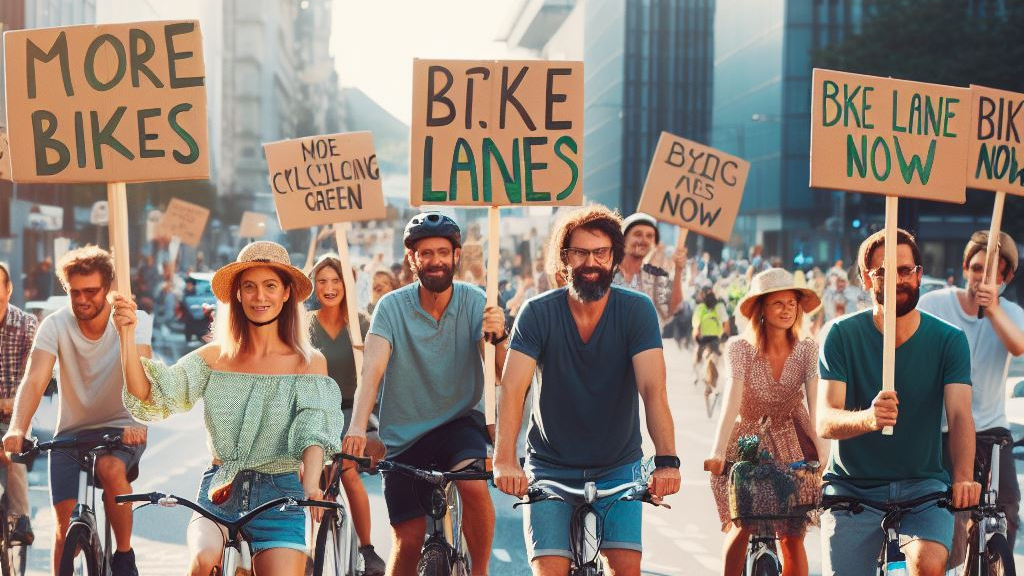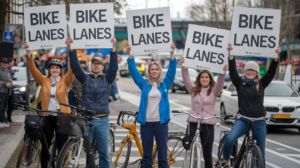How To Empower Communities Through Bicycle Advocacy

Cycling provides so many benefits for communities and the environment. Lets raise awareness to all the positive changes cycling can bring.
*This article may contain affiliate ads that help to support this site*
In today’s fast-paced world, where traffic congestion, pollution, and sedentary lifestyles are prevalent, bicycle advocacy has emerged as a powerful movement, promoting sustainable transportation and healthier communities. Bicycle advocacy refers to the collective efforts aimed at improving cycling infrastructure, raising awareness about the benefits of bicycling, and creating a safe and inclusive environment for cyclists. Whether you’re a dedicated cyclist or someone who recognizes the need for change, bicycle advocacy plays a crucial role in reshaping our cities and towns. Join me as we explore the multifaceted world of bicycle advocacy, understanding its significance, and discovering ways to make a positive impact on our surroundings through the power of pedals.
Benefits Of Cycling
1) Health Benefits of Cycling: When it comes to physical fitness, bicycling is a fantastic way to stay active and improve your overall well-being. Regular cycling helps strengthen muscles, improve cardiovascular health, and enhance lung capacity. It’s a low-impact exercise that reduces the risk of joint problems compared to high-impact activities like running. Cycling also aids in weight management, as it burns calories and boosts metabolism. Additionally, it has been linked to improved mental health, reducing stress levels, and promoting a positive mood. By incorporating cycling into your daily routine, you can experience these numerous health benefits while enjoying the outdoors.
2) Environmental Advantages of Bicycle Transportation: In the fight against climate change, bicycles play a significant role in reducing greenhouse gas emissions and combating pollution. Unlike motor vehicles, bicycles emit no harmful gasses or particulate matter, making them an eco-friendly mode of transportation. By choosing to cycle instead of drive for short trips or commuting, you contribute to cleaner air and a healthier environment. Additionally, bicycles require minimal resources for production and maintenance compared to automobiles, further reducing their carbon footprint. Embracing bicycle transportation can help create greener and more sustainable cities, benefiting both present and future generations.
3) Economic Benefits of Promoting Cycling: Promoting cycling as a means of transportation brings about several economic advantages. First and foremost, it helps reduce the strain on infrastructure, as bicycles require less space than motor vehicles and alleviate traffic congestion. This, in turn, reduces the need for costly road expansions and parking infrastructure. Furthermore, cycling promotes local businesses, as cyclists tend to spend more at shops and restaurants within their communities. By encouraging bicycle tourism and creating cyclist-friendly destinations, cities can attract visitors and stimulate economic growth. Investing in cycling infrastructure and initiatives not only benefits individuals but also provides economic opportunities for the entire community.
4) Reduced Public Health Costs: Moreover, cycling can contribute to improved public health outcomes, leading to cost savings for healthcare systems. Regular physical activity, such as cycling, helps prevent chronic diseases like obesity, heart disease, and diabetes. By promoting cycling, communities can reduce the burden on healthcare resources and redirect those funds to other essential services. Additionally, with the rise of remote work and flexible schedules, cycling can offer an active commuting option that promotes work-life balance and reduces transportation costs for individuals and families.
5) Bringing the Community Closer Together: Furthermore, embracing a cycling culture fosters social connectivity and community engagement. Cycling can be a social activity, allowing people to bond through group rides, cycling clubs, and community events. By encouraging active transportation, cities and neighborhoods become more vibrant and livable, with increased opportunities for interaction and a sense of belonging.
The benefits of bicycling go beyond personal gains. By adopting cycling as a means of transportation, we can contribute to a healthier population, a cleaner environment, and more vibrant local economies. The advantages of bicycling are not limited to individual well-being but extend to the collective progress of our communities. So, let’s hop on our bikes and pedal towards a brighter and more sustainable future for all.
Challenges Faced By Cyclists
1) Lack of Infrastructure for Cyclists: One of the primary challenges faced by cyclists is the inadequate infrastructure to support safe and convenient cycling. Many cities and towns lack proper bike lanes, bike paths, and bike parking facilities. This forces cyclists to navigate through busy streets alongside motor vehicles, increasing the risk of accidents and discouraging potential cyclists from taking up cycling as a mode of transportation.
The lack of dedicated infrastructure also hampers the integration of cycling into public transportation systems, making it difficult for cyclists to combine biking with other modes of travel. To overcome this challenge, it is crucial for cities to invest in comprehensive cycling infrastructure, including separated bike lanes, well-connected bike networks, and secure bike parking facilities, creating a safe and efficient cycling environment.
2) Safety Concerns and Accidents Involving Cyclists: Cyclists often face safety concerns on the roads, as they are more vulnerable than motor vehicle occupants. Lack of awareness and respect from other road users, particularly drivers, poses a significant risk to cyclists. Reckless driving, speeding, and distracted driving can lead to accidents and serious injuries for cyclists. Furthermore, inadequate street lighting and poor road conditions can further compromise the safety of cyclists, especially during nighttime rides.
To address these challenges, efforts should be made to educate both cyclists and motorists about road safety, enforce traffic laws, and improve infrastructure design to prioritize cyclist safety. Initiatives such as “Share the Road” campaigns and driver education programs can help promote a culture of respect and awareness among all road users.
3) Attitudes Towards Cycling in the Community: Despite the growing popularity of cycling, negative attitudes towards cyclists persist in some communities. Cyclists may face hostility, aggression, or even harassment from motorists or pedestrians who view them as obstacles or nuisances on the road. This negative perception can discourage people from embracing cycling as a mode of transportation.
To address this challenge, community engagement and awareness programs are crucial. Encouraging dialogue, promoting empathy, and highlighting the benefits of cycling can help change perceptions and foster a more inclusive and supportive environment for cyclists. Additionally, involving local leaders, businesses, and schools in advocacy efforts can create a sense of ownership and encourage the community to embrace cycling as a viable and respected mode of transport.
By addressing these challenges, we can create a safer and more inclusive cycling environment. It is essential to prioritize cycling infrastructure, improve road safety measures, and promote a positive attitude towards cycling within communities. Only by overcoming these obstacles can we truly harness the potential of cycling as a sustainable and healthy mode of transportation.
The Role Of Bicycle Advocacy
1) Definition and Goals of Bicycle Advocacy: Bicycle advocacy encompasses the collective efforts of individuals, organizations, and communities to promote and improve conditions for cycling. It aims to advocate for the rights and needs of cyclists, working towards creating a safe, accessible, and supportive cycling environment. The goals of bicycle advocacy include enhancing cycling infrastructure, raising public awareness about the benefits of cycling, influencing policy decisions, and fostering a culture that embraces cycling as a sustainable mode of transportation.
2) Advocacy Organizations and Their Initiatives: Numerous advocacy organizations at local, regional, and national levels are dedicated to advancing bicycle advocacy. These organizations play a vital role in representing the interests of cyclists and driving positive change. They engage in various initiatives, such as lobbying for cycling-friendly policies, collaborating with government agencies and transportation planners, organizing events and campaigns, and providing resources and education to promote safe cycling practices. Through their work, advocacy organizations create a strong collective voice for cyclists, ensuring their needs are heard and addressed.
3) Successful Examples of Bicycle Advocacy Efforts: Over the years, bicycle advocacy has resulted in significant improvements for cyclists in many communities. Successful initiatives include the establishment of dedicated cycling infrastructure, such as bike lanes, bike paths, and bike-sharing programs. Advocacy efforts have also led to the implementation of traffic calming measures, reduced speed limits, and improved road safety for cyclists. Furthermore, advocacy organizations have been instrumental in raising public awareness about cycling benefits, influencing public opinion, and fostering positive attitudes towards cyclists.
One notable example of successful bicycle advocacy is the transformation of cities through the implementation of comprehensive cycling networks. Cities like Copenhagen, Amsterdam, and Portland have become global models for cycling-friendly infrastructure and culture. Through persistent advocacy and collaboration between advocacy groups, city officials, and community members, these cities have created safe and convenient cycling networks, making cycling a preferred mode of transportation for a significant portion of the population.
In addition to physical infrastructure, bicycle advocacy has also played a crucial role in promoting policy changes. Examples include the adoption of Complete Streets policies, which prioritize the needs of all road users, and the inclusion of cycling in urban planning and transportation strategies. These policy changes reflect the influence of bicycle advocacy in shaping more sustainable and people-centered cities.
By actively engaging in bicycle advocacy, individuals can contribute to creating a more cycling-friendly society. Whether by joining local advocacy groups, participating in community initiatives, or advocating for cycling-related policies, individuals can make a meaningful difference. Together, through bicycle advocacy, we can work towards building communities that prioritize and support cycling as a sustainable and healthy mode of transportation.

Hide A Bike Kit
Is your garage starting to become a mess? Save space by storing your bikes flat against the ceiling.
Strategies For Effective Advocacy
1) Public Awareness Campaigns and Education Programs: One of the key strategies for effective bicycle advocacy is raising public awareness about the benefits of cycling and the importance of supporting cyclists. Advocacy groups can organize public awareness campaigns, utilizing various media platforms to promote cycling as a sustainable and healthy mode of transportation. These campaigns can highlight success stories, share cycling safety tips, and debunk common myths about cycling. Education programs targeted at both cyclists and motorists can also play a crucial role in promoting safe and respectful interactions on the road. By providing resources, workshops, and training sessions, advocacy groups can empower individuals with the knowledge and skills to navigate the cycling environment confidently.
2) Collaborations with Local Government and Community Leaders: Effective bicycle advocacy often requires collaboration with local government officials, transportation planners, and community leaders. Advocacy groups can work closely with these stakeholders to influence policy decisions and ensure that cycling infrastructure is prioritized in urban planning initiatives. By establishing strong relationships and open lines of communication, advocacy groups can effectively convey the needs and concerns of cyclists and actively contribute to decision-making processes. Collaborations can also involve organizing joint events, such as bike rides with community leaders, to showcase the benefits of cycling and build support for cycling initiatives.
3) Lobbying for Improved Cycling Infrastructure and Policies: Advocacy groups play a critical role in lobbying for improved cycling infrastructure and policies at local, regional, and national levels. By engaging in advocacy efforts, such as writing letters, meeting with policymakers, and participating in public consultations, advocates can influence decision-makers to allocate resources and prioritize cycling projects. This includes advocating for the development of bike lanes, bike-friendly intersection designs, secure bike parking facilities, and the integration of cycling into public transportation systems. Additionally, advocating for cyclist-friendly policies, such as the adoption of Complete Streets policies, can help create a safer and more accessible environment for cyclists.
4) Utilizing Technology and Social Media: In the digital age, leveraging technology and social media platforms is a powerful strategy for effective bicycle advocacy. Advocacy groups can utilize websites, blogs, and social media channels to share information, updates, and success stories. By engaging with the online community, advocates can build a broader network of supporters, raise awareness, and mobilize individuals to take action. Social media platforms also provide a platform for sharing cycling-related news, promoting events, and advocating for policy changes. The power of social media lies in its ability to amplify voices, reach a wider audience, and foster a sense of community among cyclists and advocates.
By employing these strategies, advocates can maximize their impact and drive positive change for cycling. Effective bicycle advocacy involves a multi-faceted approach, combining public awareness campaigns, collaborations with stakeholders, lobbying efforts, and leveraging technology. Together, these strategies can create a strong and united voice for cycling, paving the way for a more bike-friendly and sustainable future.
How To Get Involved In Bicycle Advocacy
1) Join Local Bicycle Advocacy Groups: One of the most effective ways to get involved in bicycle advocacy is by joining local advocacy groups. These organizations are at the forefront of promoting cycling and working towards improving conditions for cyclists in your community. Research and find advocacy groups in your area and become a member. By joining, you will gain access to resources, events, and opportunities to actively participate in advocacy initiatives. You can contribute your ideas, skills, and passion for cycling while connecting with like-minded individuals who share your enthusiasm for promoting sustainable transportation.
2) Volunteer for Advocacy Events and Initiatives: Advocacy groups often organize various events, initiatives, and campaigns to raise awareness and promote cycling. Volunteering your time and skills for these activities is an excellent way to make a meaningful impact. You can help organize community bike rides, assist in setting up bike safety workshops, or participate in campaigns advocating for improved cycling infrastructure. Volunteering allows you to directly contribute to the success of advocacy efforts while engaging with the wider community and inspiring others to embrace cycling.
3) Engage With Local Government Officials: Your voice matters, and engaging with local government officials is a powerful way to advocate for cycling. Attend city council meetings, transportation planning sessions, or public consultations where decisions about cycling infrastructure and policies are discussed. Share your insights, experiences, and concerns about cycling in your community. By directly communicating with policymakers, you can raise awareness of the importance of cycling, provide input on cycling-related projects, and advocate for cyclist-friendly policies. Building relationships with government officials and staying informed about ongoing initiatives will help you stay actively involved in the decision-making processes.
4) Promote Cycling Within Your Network: Another impactful way to advocate for cycling is by promoting it within your network of friends, family, and colleagues. Share your positive experiences of cycling and the benefits it brings to your life. Encourage others to consider cycling for short trips, commuting, or recreational activities. By being a vocal advocate for cycling, you can inspire others to give it a try and contribute to normalizing cycling as a preferred mode of transportation. Encourage conversations about cycling, answer questions, and address concerns people may have. Your passion and advocacy can have a ripple effect, encouraging others to join the movement and make positive changes in their own lives.
5) Stay Informed and Educated: To be an effective bicycle advocate, it’s essential to stay informed and educated about cycling-related topics. Stay up-to-date with current trends, policies, and research related to cycling and transportation. Read books, articles, and reports on bicycle advocacy, urban planning, and sustainable transportation. Attend conferences, webinars, or workshops related to cycling and advocacy. By expanding your knowledge, you will have a stronger foundation to contribute to discussions, advocate for evidence-based solutions, and make informed decisions as an advocate.

Hide-A-Bike Installation Guide
If you want to put together a Hide-A-Bike kit for yourself, just download these easy to follow, step-by-step directions, complete with a full hardware and parts list.
Conclusion
By getting involved in bicycle advocacy, you can be an agent of change in promoting cycling as a sustainable and healthy mode of transportation. Joining advocacy groups, volunteering, engaging with local government officials, promoting cycling within your network, and staying informed are all powerful ways to make a meaningful impact. Remember, every effort, no matter how small, contributes to creating a more cycling-friendly world. Together, we can build communities that prioritize cycling, leading to healthier individuals, cleaner environments, and more vibrant cities.
Share This Article With A Friend
Did You Read This Whole Article?

You deserve a gift! Enter your email to receive a FREE copy of the Hide-A-Bike Installation Guide! And once a month we will send you a newsletter with the best deals on the internet for bicycle gear and accessories.
About Hide A Bike

Save space by keeping your bike flat against the ceiling with the original easy and convenient bicycle storage solution.
Thank You For Visiting!

You deserve a gift! Enter your email to receive a FREE copy of the Hide-A-Bike Installation guide. And once a month we will send you a newsletter with links to our best finds on bicycle gear and accessories.
Share This Article:
Most Popular Articles:
Article Categories:
Related Articles:

Wheels Of Change: The Role Of Bicycles For Social Justice

Explore The Unique Bond Of Biking With Your Dog






